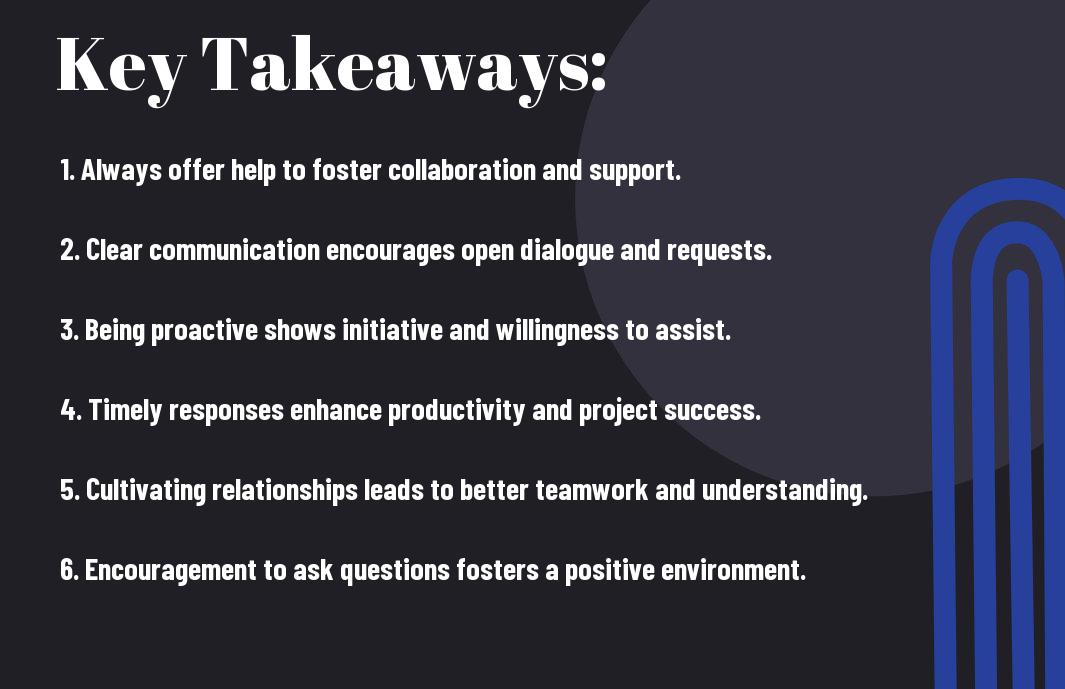You are not alone on this journey, and I’m here to help you navigate through it! In this guide, you will discover practical tips and resources designed to provide support when you might feel overwhelmed or uncertain. Recall, asking for help is a sign of strength, and there’s no such thing as a silly question when it comes to seeking clarity. Whether you’re tackling a complex project or just need a pep talk, feel free to reach out; together we can make it smoother!

The Power of Asking
A crucial aspect of reaching out and seeking help lies in understanding the power of asking. When you ask for assistance, you’re not merely looking for solutions; you’re building connections and fostering relationships that can enrich your life. It can sometimes feel daunting to seek help, but remember that everyone, at some point, has had to lean on someone else. It’s a beautiful reminder that we are all in this together, navigating the twists and turns of life side by side.
Breaking Down Barriers
Barriers can often form in your mind, creating a sense of isolation that keeps you from reaching out when you truly need support. These barriers might manifest as doubts about your worthiness or fears of being a burden to others. Overcoming these mental hurdles is key to unlocking the potential of asking for help. When you break down these barriers, you not only access assistance but also bolster your own self-worth. Embracing vulnerability can lead to here-and-now moments filled with connection and understanding.
Overcoming Fear and Pride
Overcoming the twin forces of fear and pride is an imperative step towards seeking assistance. Fear of rejection or judgment can paralyze even the most proactive among us. You might worry that asking for help will make you appear weak or incapable, which can keep you from speaking up when you need it most. Letting go of that pride allows you to see that asking for help is not a weakness; it is an act of strength and courage. Your willingness to be honest about your struggles invites others to do the same.
For instance, when you look around, you’ll find a plethora of stories where individuals stepped past their fear and pride to reach out. They discovered that their struggles resonated with others and that asking for help opened doors to new friendships and support systems. Instead of shielding themselves from potential vulnerability, they embraced it, realizing that opening up could lead to powerful opportunities, growth, and understanding. So, the next time you feel yourself hesitating to ask, remember that it can be the gateway to deeper connections.

Identifying Your Needs
Some people rush through the process of identifying their needs, missing out on invaluable insights. It’s vital to slow down for a moment to engage in self-reflection and awareness. This is where you can take a step back and really think about what is vital for you right now. Often, our needs are veiled by the chaos of daily life, and it takes a gentle nudge to pull them into focus. By tuning into your feelings, experiences, and desires, you can begin to uncover what truly resonates with you. You might find that what you thought you needed was merely a distraction, holding you back from embracing what really serves you.
Self-Reflection and Awareness
Needs shift and evolve, reflecting changes in your life circumstances and emotional state. It’s during moments of clear self-reflection that you can gather the strength to face these shifts. What is it you truly seek? This is not just about material things; it’s deeply personal. Take a journal and write down your thoughts; explore the why behind each need. Ask yourself probing questions: What do I crave for my well-being? What injustices or discontent am I feeling that call for acknowledgment? You may uncover needs related to support, fulfillment, or even just a little more joy in your day-to-day. It’s a little like being a detective of your own heart.
Clarifying Your Goals and Objectives
Needs don’t exist in isolation—they are intertwined with your goals and aspirations. As you work to clarify your goals, consider what you want to achieve in both the short and long term. Write down your objectives, focusing on how you can align your fundamentally human needs with actionable steps. This creates a sense of direction, allowing you to break your larger aims into manageable pieces. When you clarify your goals, you naturally begin to identify what you need to succeed. You may discover necessary resources, support systems, or even personal development opportunities that were previously under your radar.
To dig deeper, consider creating a list or map of your goals, outlining not just what you want to achieve but also what you’ll need to get there. This process is liberating, helping you navigate towards your dreams while recognizing that your needs are valid and worthy of attention. Don’t shy away from acknowledging your requirements as you work towards fulfilling your aspirations; they are stepping stones and tools that will empower you on your journey to becoming your best self.
Effective Communication
All great relationships, whether personal or professional, are built on the foundation of effective communication. It’s not just about exchanging words; it’s about understanding, connecting, and responding in a way that fosters trust and openness. So, let’s explore some key aspects that will enhance how you communicate with others, particularly when offering or seeking assistance. When you can express yourself clearly, the chances of misunderstanding drop significantly, allowing for smoother exchanges.
Clear and Concise Language
To communicate effectively, using clear and concise language is vital. This means stripping away the jargon, and complicated expressions, and getting straight to the point. You want your message to be easy to understand, thus making the information accessible to your audience. Whether you’re composing an email or having a conversation, clarity will help your recipients grasp your thoughts and intentions more readily.
To achieve this, consider the main idea you want to convey and stick closely to it. Avoid extraneous details that may confuse or distract your listener or reader. When people can easily identify the crux of your communication, it builds their confidence in you and enhances your relationship. Be mindful of, being clear doesn’t mean being simplistic; it means being thoughtful about how you share your message!
Active Listening and Feedback
Feedback is one of the most powerful tools in effective communication. It encourages an open dialogue where you can express your thoughts while also receiving critical input that benefits everyone involved. Through active listening, you demonstrate genuine interest in what the other person has to say. This means truly focusing on their words, rather than merely waiting for your turn to speak.
When you practice active listening, you’ll find it easier to provide constructive feedback that respects the other person’s perspective while effectively conveying your point. By acknowledging their feelings and validating their experience, you solidify a rapport that fosters honest discussions. This two-way street of communication not only builds trust but also encourages collaborative problem-solving, making room for innovative and positive outcomes.
Communication is a vital aspect of every interaction, and it’s vital to hone these skills continuously. Be mindful of, the way you communicate impacts not just your message, but also your relationships. By employing clear language and engaging in active listening, you can create a positive environment where everyone feels heard and valued—a place where genuine assistance can flourish!
Building Trust and Rapport
Once again, let’s reflect on the vital foundations of communication: trust and rapport. These two elements are crucial in any relationship, particularly when you’re in a position to offer assistance. When you show that you genuinely want to help, it sets the stage for a successful interaction. But how do you cultivate this vital connection? The answer lies in a blend of understanding, shared experiences, and an open heart. People are more likely to accept your guidance when they feel safe and valued in your presence.
Establishing Common Ground
To establish common ground, start by recognizing the similarities you share with the person you are assisting. You may both be navigating through similar situations, facing the same challenges, or even sharing interests or values. By articulating these connections, you create an instant bond that assures them they’re not alone in their journey. This sense of shared experience not only enhances your rapport but also fosters a more accessible platform for dialogue.
Think of it as a bridge over which both of you can walk; the more common experiences or values you identify, the sturdier that bridge becomes. You might ask open-ended questions to draw out these commonalities. People love to talk about themselves, and who knows, you might find out you both love the same coffee shop or have a passion for hiking. These little nuggets of shared interests can strengthen your networking ties immensely.
Showing Empathy and Compassion
Building trust also involves demonstrating empathy and compassion. This is where your heart needs to take the wheel. When you actively listen and validate someone’s feelings without judgment, you create a safe space. Note, it’s not just about finding solutions; it’s also about being present, fully engaged, and offering reassurance. You might say something like, “I can only imagine how difficult this must be for you,” which indicates to them that you not only hear their concerns but genuinely care.
Rapport blossoms when individuals feel seen and understood. This approach can transform their experience from overwhelming to manageable. It’s critical to avoid dismissive language that may make them feel less significant. Instead, allow your body language to convey openness—nodding, leaning slightly forward, and maintaining eye contact are simple but powerful ways to show that you’re in their corner. Empathy is your superpower in these situations, creating a bond that facilitates trust, respect, and an effective dialogue. The next time you find yourself offering assistance, remember this gentle art; it is the key to making lasting connections.
Navigating Different Assistance Scenarios
Despite the challenges you may face in seeking help, understanding how to navigate different assistance scenarios can significantly lighten your load. Sometimes, you’ve just got to reach out, whether it’s for reassurance, clarity, or even a fresh perspective. You don’t have to go through every hurdle alone; all you need to do is ask. So take a deep breath, and let’s explore the avenues where support is readily available.
Seeking Help from Peers and Colleagues
Any time you find yourself in a pinch, your peers can be an invaluable resource. They understand the dynamics of your environment and often have insights rooted in shared experiences. You might be surprised by how willing they are to assist, whether by brainstorming solutions, providing feedback, or simply encouraging you to keep going. When you reach out to a colleague, remember that fostering a spirit of collaboration not only strengthens relationships but also leads to creative solutions that you might have never considered on your own.
As you engage with your peers, don’t hesitate to share your own skills and knowledge as well. The most rewarding exchanges happen when you create a two-way street of assistance. By openly offering support, you build a network of trust and camaraderie, where every individual feels valued and empowered. After all, sometimes your tiny nugget of advice could be exactly what someone else needs to overcome their stumbling block.
Working with Experts and Mentors
Peers help, but stepping up your game to seek guidance from seasoned experts can take your understanding to another level. Any involvement with mentors or specialists offers a *goldmine of insights* and wisdom rooted deeply in their experiences. They’ve weathered storms you might be facing and can help you navigate treacherous waters more effectively. Reach out with an open mind; you’ll likely find they’ve got a treasure trove of practical strategies or life lessons that could change your approach entirely.
Understanding the dynamics of working with experts and mentors provides you with the chance to harness their expertise towards your goals. These individuals often have unique viewpoints and have encountered significant obstacles in their journey, making their advice incredibly applicable to your situation. Cultivate a relationship where you feel comfortable asking questions and sharing your challenges. The value of their feedback can be transformative, bringing in an external perspective that’s hard to achieve alone. Their insights can help you identify your strengths, opportunities for growth, and crucially, help you avoid common pitfalls that they may have faced. Engaging with mentors means you are investing in your personal and professional development, which is a profoundly positive step towards reaching your full potential.
Embracing Vulnerability
Keep in mind that embracing vulnerability is not about exposing yourself to everyone but rather about revealing your authentic self to those you trust and who support you. This journey is crucially about letting go of the armor you have constructed over the years to protect your inner self. You might feel the urge to retreat into your shell when faced with the idea of being vulnerable, but the true alchemy happens when you allow yourself to be seen, flaws and all. Note, it requires patience and courage, but the rewards are boundless, deepening your connections and fostering genuine relationships.
Letting Go of Ego and Control
Letting go of your ego is a daunting task, but it is crucial if you want to connect with others on a deeper level. Your ego often feeds on control, making you believe that you have to manage every aspect of your life and interactions. However, the truth is that surrendering control can open doors to relief, trust, and honesty. It may feel uncomfortable at first—perhaps even a little terrifying—but by relinquishing these mental shackles, you enable yourself to experience vulnerability in its most liberating form. This, in turn, invites those around you to respond with empathy rather than judgment.
Letting go of control requires you to challenge the narratives that keep you stuck in a cycle of self-doubt and defensiveness. You might find it liberating to allow your thoughts and feelings to flow freely, recognizing that your worth is not contingent on being perfect or in control. In doing so, you amplify your capacity for authentic connections with others, ultimately creating a safe space where vulnerability thrives. Each time you let go and embrace this uncertainty, you inch closer to a fuller, more meaningful existence.
Cultivating Humility and Open-Mindedness
Letting go of preconceived notions is a beautiful step towards cultivating humility and open-mindedness. Understanding that you don’t have all the answers—nor do you need to—is pivotal. This openness to new perspectives not only fosters connection but also enriches your own personal growth. Being humble means recognizing that every individual has their journey and struggles, and by adopting this mindset, you allow yourself to learn from their experiences and insights.
The practice of humility is powerful, as it reminds you that you are part of a larger tapestry of humanity. Embracing this shared experience not only helps you to be more compassionate towards yourself but also toward others. When you’re able to step back and acknowledge that everyone has their battles, you create a more understanding environment where vulnerability is welcomed. As you cultivate this open-mindedness, you foster space for growth, connection, and authenticity, reassuring you that it is indeed okay to reach out for support when needed.
Conclusion
The journey toward finding the answers and solutions you seek can be a winding path, but remember, you’re not alone in this journey. Whenever you find yourself in need of guidance or a gentle nudge in the right direction, don’t hesitate to reach out. Your curiosity and quest for knowledge are commendable, and asking for assistance is a sign of strength rather than inadequacy. It shows your willingness to learn and grow, and that’s something to celebrate.
As you continue to navigate through life’s questions, keep in mind that support is always just a message away. Whether it’s a simple request for clarification or a deeper exploration of a topic, the invitation remains open. So go ahead, tap into that well of resources around you—your questions are valid, and your pursuit of understanding and clarity is not just welcomed, it’s cherished. Let me know if you need any more assistance; it would be my pleasure to help you along the way!
FAQ
Q: What does “Let Me Know If You Need Any More Assistance!” mean?
A: This phrase is an offer of help or support and is typically used in communication to indicate that the speaker is available for further assistance or clarification if needed. It encourages the recipient to feel comfortable reaching out for more information or help.
Q: In what situations can I use this phrase?
A: You can use this phrase in various situations including professional emails, customer service interactions, or personal conversations. It is appropriate to use when you want to ensure others know you are open to providing additional help or are willing to continue a discussion on a topic.
Q: How can I respond if someone says “Let Me Know If You Need Any More Assistance!”?
A: A suitable response can vary based on your needs. If you require further help, you can reply with a specific question or by stating what assistance you need. If you do not need any more assistance, you can acknowledge their offer by saying something like, “Thank you, I think I have everything I need for now!”
Q: Is this phrase formal or informal? Should I only use it in certain contexts?
A: The phrase is flexible and can be used in both formal and informal contexts. In professional settings such as business emails, it conveys a willingness to assist, while in casual conversations, it shows a friendly offer to help. However, it’s always good to consider the relationship you have with the person you are communicating with when deciding how to use it.
Q: Can I rephrase “Let Me Know If You Need Any More Assistance!”? What are some alternatives?
A: Yes, there are many alternatives you can use. Some alternatives include: “Feel free to reach out if you have any questions,” “If you need anything else, just let me know,” or “I’m here to help if you need further assistance.” These variations maintain the same supportive tone while providing a fresh expression.



